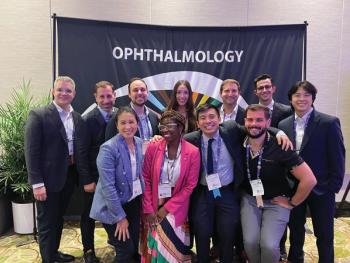
Nanotechnology strategies explored as novel therapeutic approach to photoreceptor blindness
Nanotechnology-based approaches for restoring sight in patients with retinal degenerative diseases hold great interest because they offer potential advantages compared with a retinal prosthesis, said Marco A. Zarbin, MD, PhD.
Dr. Zarbin described three nanoscale technologies that are currently in development. He explained that they represent an exciting approach for several reasons.
“In principle, the nanotechnology approaches may be safer than a retinal prosthesis and give better spatial resolution,” said Dr. Zarbin, professor and chair, Institute of Ophthalmology and Visual Science, Rutgers-New Jersey Medical School Rutgers University, Newark, NJ.
“In addition, some of the approaches that are being developed offer reversibility, and that is an important feature because it means patients will have the opportunity to take advantage of new and better approaches if they come along,” Dr. Zarbin said.
Compared with a retinal prosthesis, nanoscale technology approaches offer the potential for providing higher spatial resolution because they can deploy far more cells as photoreceptors, ie., about 1 million ganglion cells or 10 million bipolar cells. Their safety advantage relates to the fact that they are delivered using intravitreal or subretinal injections rather than requiring major intraocular surgery.
Three distinct approaches
Optogenetics is the first nanotechnology-based approach Dr. Zarbin discussed. It involves transfecting neurons to express light-activated molecules linked to ion channels, which allows the neurons to initiate a synaptic signal when exposed to light.
“A potential disadvantage of this approach is that it is probably not reversible,” Dr. Zarbin said.
Two companies, Allergan and GenSight Biologics, have clinical trials underway investigating an optogenetics approach to restore sight in patients with advanced retinitis pigmentosa (RP). Both companies are using a recombinant adeno-associated viral vector to transfect retinal ganglion cells with a channelrhodopsin-2 gene. Because activation of synaptic transmission with channelrhodopsin-2 requires exposure to very bright light, patients in the GenSight study are being given special glasses to amplify the external visual stimulus to the optogenetically engineered retina.
“Development of this technology using alternative light sensing molecules such as rhodopsin is moving forward,” Dr. Zarbin said.
The second nanotechnology-based approach is known as the photoswitch. It is based on using light to induce a change in molecular configuration that leads to light-induced activation of voltage-gated ion channels and, subsequently, synaptic transmission.
Dr. Zarbin described an in vitro study done in tissue culture that provided proof of principle for the photoswitch approach using the photochromic ligand, DAD. In addition, studies in animal models showed that intravitreal injection of DAD led to a positive change in visual-guided behavior.
“A remarkable feature of the photoswitch approach using DAD is that it changes retina sensitivity to light only in areas lacking photoreceptors, but it has no effect in areas of the retina where the photoreceptors are still viable, even if the cells are not functional,” Dr. Zarbin said.
Based on this selective activity, Dr. Zarbin envisioned that the photoswitch approach could be used as an early intervention to improve peripheral vision in patients with RP when they still retain 20/20 visual acuity.
Unlike the optogenetics approach, DAD-induced light sensitivity has a relatively short half-life. Therefore, it offers reversibility and the opportunity to do dose titration.
“The amount of DAD needed may be different in different patients. The reversible nature of the treatment would permit experimenting with the dose to find the one that might work best for an individual patient,” Dr. Zarbin said. “It also allows patients to retain the option to switch to an alternative treatment should a better one become available.”
Another advantage of the photoswitch approach compared with optogenetics is that the pathway for regulatory approval of the photoswitch is probably less complex. Downsides of the current photoswitch approach using DAD are that the molecule stains the lens and vitreous, and it has relatively low light sensitivity.
The third nanoscale technology Dr. Zarbin described involves quantum dots, which are nanoparticles made of semiconductor material. When exposed to light, quantum dots can generate an electric current or a dipole moment that causes voltage-gated ion channel activation in adjacent retinal neurons and therefore synaptic transmission. Dr. Zarbin noted that quantum dots are generally toxic. They are rendered safe by applying a coating, but the coating also limits the strength of the electric current or dipole moment that can be generated.
“Coated quantum dots only generate pico amps of current, which is only one-millionth of the level thought to be needed to stimulate degenerated retina. Our concept about the amount of current that may be needed may be wrong, however, considering that results were observed using quantum dots in an animal model of an uncommon form of RP,” Dr. Zarbin said.
In the preclinical study, animals receiving ten trillion cadmium-selenium zinc oxide-biotin quantum dots by intravitreal injection demonstrated a transient increase in the scotopic ERG. Retinal histology was also found to be improved, and there were no safety signals.
The quantum dot approach also seemed to have acceptable safety in an early phase clinical trial conducted in Mexico that enrolled 20 patients with advanced RP. A clinical trial is now being planned in the United States, Dr. Zarbin said. Advantages of the quantum dot approach include reversibility-the quantum dots are rapidly cleared from the retina-and the action wavelength is tunable.
Disclosures:
Dr. Zarbin has no financial interests relevant to the topics discussed in this article.
Newsletter
Keep your retina practice on the forefront—subscribe for expert analysis and emerging trends in retinal disease management.












































